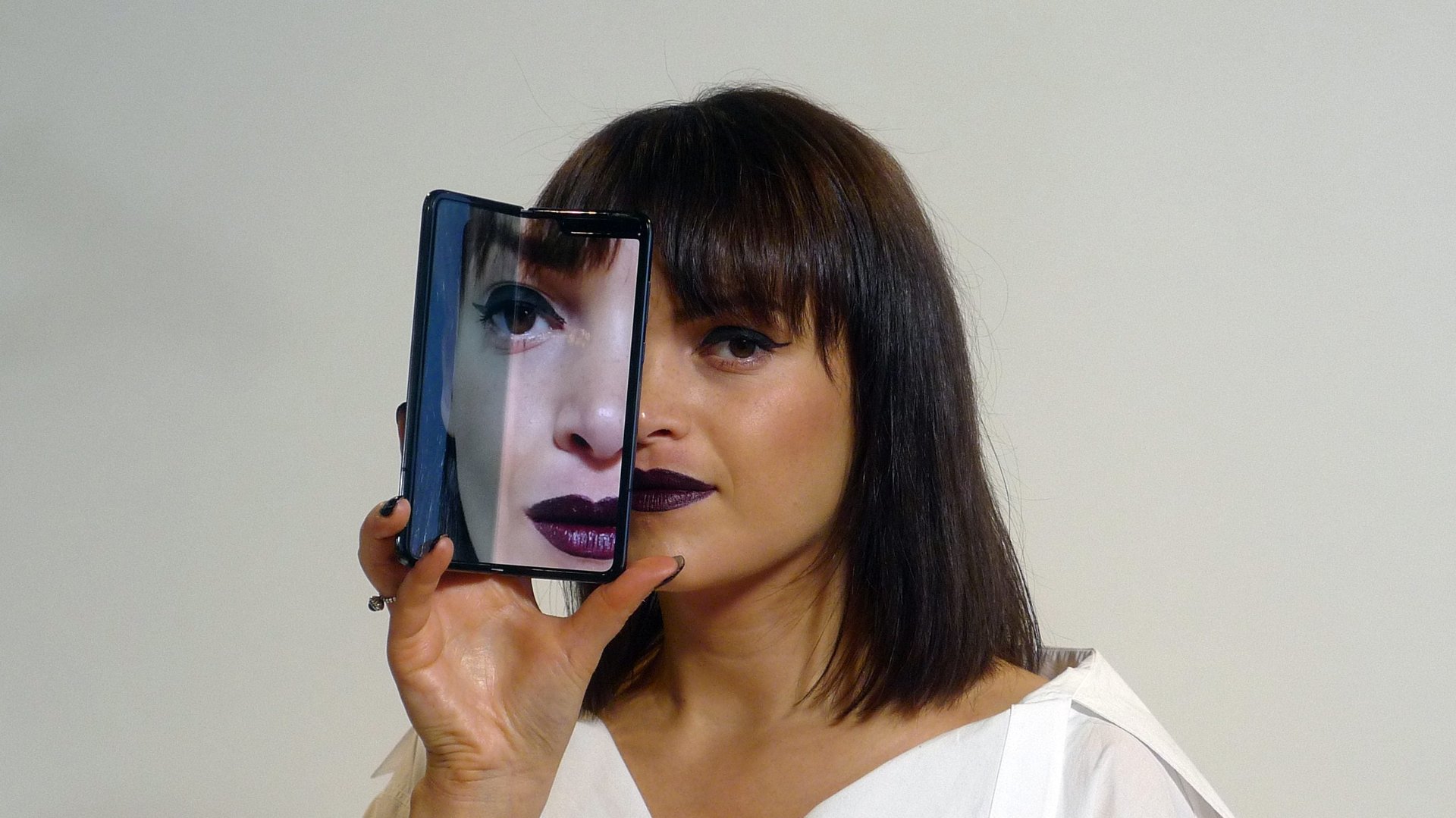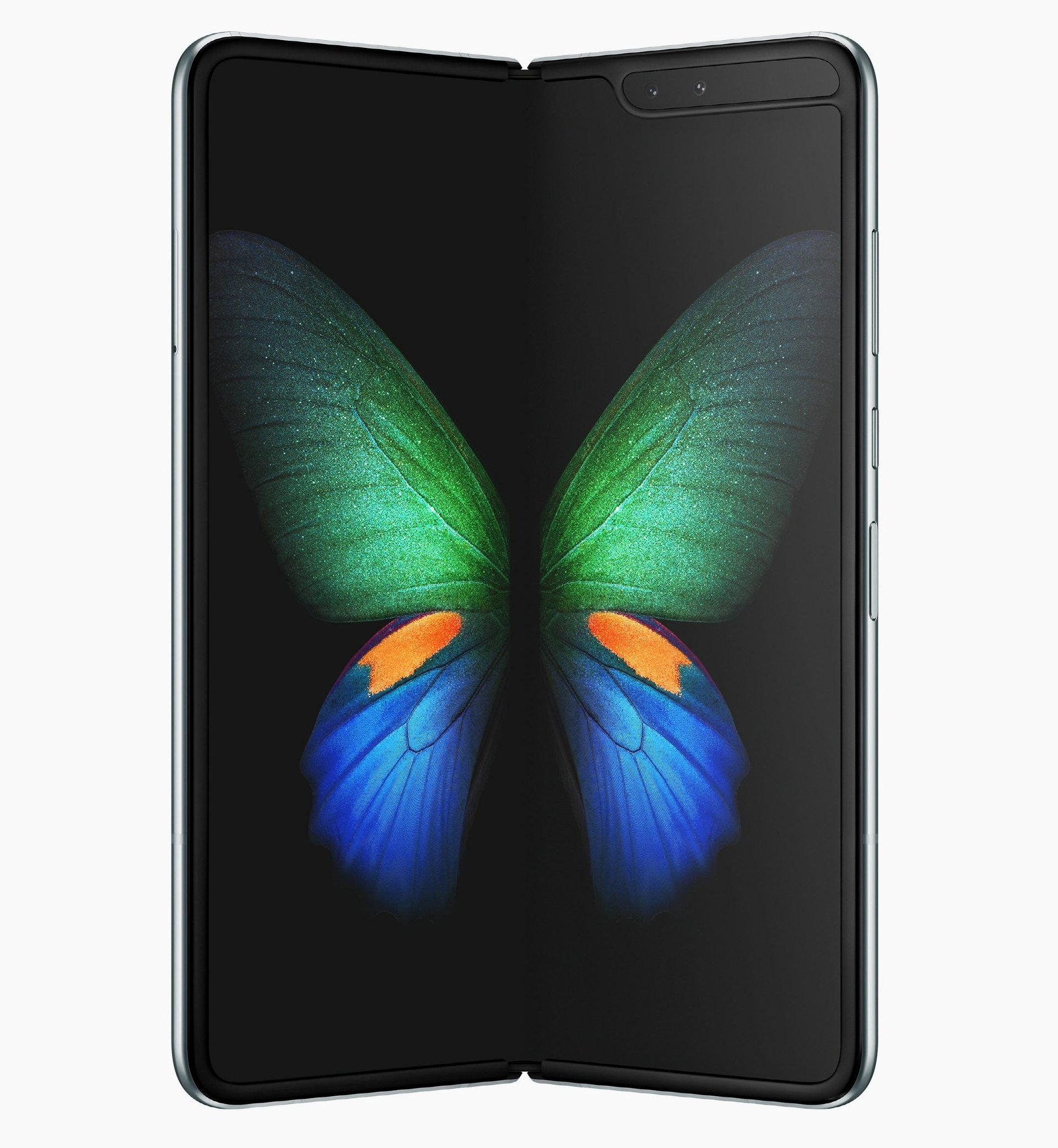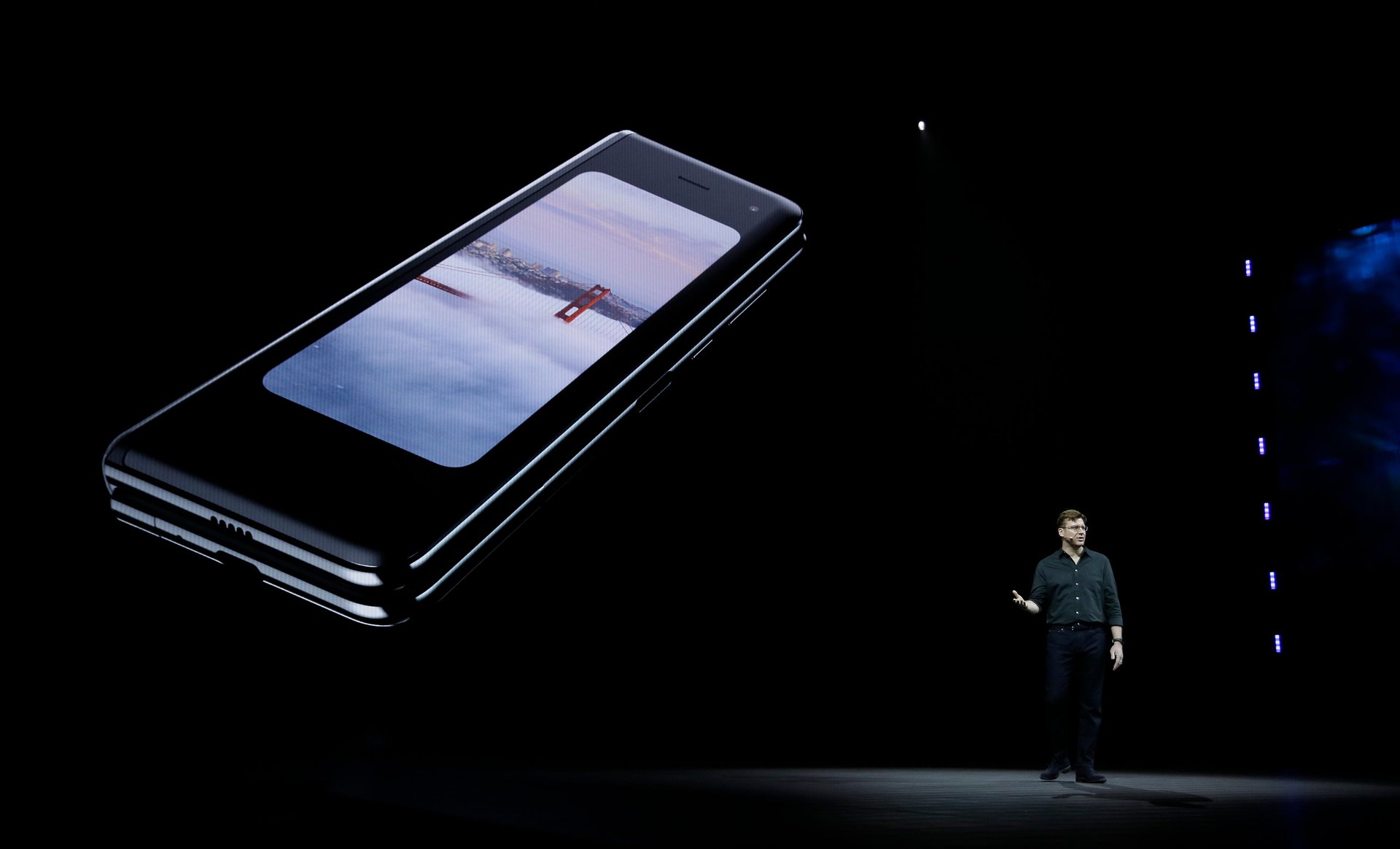The Samsung Galaxy Fold is a flawed glimpse at the future
“What is that?”


“What is that?”
“It’s a new phone from Samsung. It has a bendy screen so it can unfold.”
“Woah, that’s so cool! How much is it?”
“$2,000.”
“Ha, OK.”
I had some variation of this conversation a dozen times over the week I’ve had the Samsung Galaxy Fold, the company’s—and arguably the world’s—first mass-market foldable smartphone. Samsung’s pitch is simple: consumers continually ask for bigger screens in smaller devices. It’s tried to slake this thirst with its line of giant Note devices and the plus-sized Galaxy S phones, but with the Fold, Samsung is going even further: What if you could get a tablet-sized screen into a device that fits in your pocket?
When the Fold debuted, just about everyone was impressed by what Samsung had achieved. But many also asked: wouldn’t that break?
It turned out, it would. Four reviewers reported on April 17 that the Folds they’d been given had started breaking, with screens going black or flickering. Samsung initially replaced those review units, saying the phone had been tested to withstand over 200,000 unfolds, and that it was still on track to launch the device for public purchase on April 26. Within a week, Samsung had canned the launch and told prospective customers it was going to strengthen the smartphone’s screen’s protection, and would update them in the coming weeks on when it might actually make the device available.

Samsung told Quartz it has been working on flexible-display technology for eight years. Like many other smartphone manufacturers, it seemed to think 2019 was the year these types of products should move from science fiction to reality. (Industry-watchers expect Huawei to release a device similar to Samsung’s this summer.)
Assuming no production issues, there is still the question of whether consumers actually want to carry what is essentially a folded-up tablet in their pockets to whip out when they want to watch a YouTube clip or browse Facebook. Quartz spent the last week with the Fold to test out whether the idea of having what is basically a tablet as your only phone is realistic—regardless of whether it’s possible yet.
What’s good about the Samsung Galaxy Fold
Beautiful screen
Perhaps unsurprisingly, the 7.3-inch flexible display on the inside of the device is a joy to look at (the Fold has both an inside and outside display). For apps and content that support the full inside screen, the Fold provides an immersive experience unrivaled in any other device that fits in your pocket. Reading a book on the Kindle app feels about as close to reading an actual book as I’ve gotten on a mobile device, especially when you fold the screen slightly, so it sits in your hand as an open book does. I only wish the reader apps could treat the main screen as two discrete windows so I could read two columns of pages like an actual book.
Multitasking can be useful
With so much screen real estate, using apps in split screens actually makes sense on the Fold. Samsung has offered split-screen software on its other large devices, like the Note line of phones, but it’s theoretically far more useful on the larger screen of the Fold. You can have email and Slack running at the same time, and both are actually quite legible:
(That being said, not every app works this way, and not everything lends itself to multitasking. More on that below.)
It’s a Samsung Galaxy
Many of the best things about Samsung’s latest flagship phones are in the Galaxy Fold. Like the Galaxy S10+, it can wirelessly charge other devices on its back and has three cameras on the rear and two on the front for super-sharp photos. The Fold also goes further than other Galaxies by including 12 GB of memory and a large 4,380 mAh battery that generally lasts more than a day.
Free Galaxy Buds
Well, not really free, given that you’re paying nearly $2,000 for the phone. But in lieu of a headphone jack, Samsung throws in a pair of its very solid $130 wireless earbuds with every Fold purchase.
The camera is good
Although it can be extremely awkward to take photos on the Fold—you’re either looking at a tiny viewfinder, or holding a tablet up to take a photo—it does take some great photos. The three cameras on the back are the same as can be found on the recent Samsung Galaxy S10+, which takes excellent photos. These include two 12-megapixel cameras and one 16-megapixel, wide-angle camera, which produces some sharp and vivid photos, under the right lighting conditions:
And the Fold’s three cameras provide three different levels of zoom-range, like those on the Galaxy S10+, without any loss in picture quality:
That said, the cameras don’t hold up so well in low-light situations, or when certain filters (like the “food” filter here) are applied:
The front-facing cameras on the inside of the Fold aren’t special, but are generally fine for Skype calls and quick selfies.
It turns heads
In the years I’ve been reviewing gadgets, I don’t think a single product has made more people come up to me—on the subway, in restaurants, at bars, and in the elevator—than the Fold has. Just about everyone who’s held the Fold has marveled at what it can do, and said something like, “that’s the future!” when handing it back to me. But when I tell them it costs $2,000, they all balk.
What’s not so good about
the Samsung Galaxy Fold
I’m worried I’m going to break it
This almost goes without saying at this point, but the biggest issue with this folding phone is the fact that it folds. The display broke for multiple reviewers while testing it out: some removed a protective layer they weren’t told they shouldn’t remove (this will apparently be clearer on the final packaging); and some did nothing out of the ordinary:
I didn’t have any of those issues while testing the phone out. I’ve had it for eight days, and used it for at least a few hours each day in that time. But, every time I opened it, some part of me did worry I’d find it broken.
The tiny outer screen
The folded-up Fold is about 6.33 inches tall, but it only has a 4.6-inch screen on the outside. I found it extremely difficult to use. Before you remind me that the original iPhone had a 3.5-inch display and we all used that for years, consider that the iPhone 3G had a screen-pixel density (basically, resolution) about a third as sharp as the Fold’s. Practically, what that means is everything on the Fold’s outer screen is extremely high-resolution, but also quite small and difficult to see. The lower-resolution iPhone had bigger text and buttons to make it easier to read on the small screen, whereas the Fold defaults to miniscule text because it can: I tried typing a tweet on it once, and then never again. The overwhelming majority of my interactions with the phone were through the folded-out display, which has its own problems.

Using the full screen with one hand is difficult
Smartphones have been getting larger and more difficult to use single-handedly, and the Fold takes it to another level. If you’re trying to read a book on the Kindle app while holding on to a subway pole and want to go back a page, you’re going to have to either let go of whatever you’re holding onto to stay upright and switch hands to tap the left side of the screen, or fold the device slightly to bring the other edge of the screen closer to your thumb. Tablets are primarily intended for two-hand use, and smartphones are designed mostly for one hand. It’s no surprise that a compromise makes for an awkward experience.
The crease
It’s extremely obvious where the display folds if you hold the phone at any sort of angle other than directly head-on, which can be quite distracting.
It’s heavy
The Fold weighs over half a pound (263 grams) and you can feel it. It literally made my pants sang when I walked with it in my pocket. It’s also about twice the thickness of an average smartphone when closed:
Awkward aspect ratio
The Fold’s inner screen, when unfolded, has a ratio of 4.2:3, which is pretty close to the aspect ratio of TV sets from the 1990s. It means that when you hold the phone sideways, it’ll cram the widescreen image more typical of today’s video formats between black horizontal bars that fill the space above and below the image. The shape of the screen might feel immersive when reading a book or playing a game, but it’s awkward for most of the video content on the web.
Multi-window isn’t that useful
Being able to have two apps in a split-screen on the Fold is great, but when trying to add in a third, you’re left with two comically small windows that very few apps can realistically make use of:
It’s not water-resistant
Samsung has been releasing dust-proof and water-resistant phones for years, but the Fold, mainly because of the design compromises the team had to make to make the thing… fold… couldn’t be engineered that way.
It’s comically expensive
This phone costs about double every other high-end smartphone on the market, and more than almost every model of the Apple MacBook laptop. $2,000 is a lot of money to look futuristic.
Should you get
a Samsung Galaxy Fold
?
I always ask this question in my reviews, because, ultimately, it’s the one that matters most.
Obviously, right now, it isn’t even an option. But, most likely, the Fold—or some revamped version of it—will go on sale, and many of the issues and benefits of it will live on in whatever the device becomes.
So, if you’re the sort of person that needs to have the first version of stuff—perhaps you also own a Tesla, or you thought Google Glass was going to be a thing—then you might well have been eyeing the Samsung Galaxy Fold. And I’m not going to stop you—this thing will probably be in the Smithsonian one day, so you’ll be holding a piece of tech history. The Galaxy Fold certainly feels like the future—much like holding the original iPhone gave you the sense that this was going to be big. But much like those early smartphones, it was an idea that wasn’t fully realized—remember you couldn’t take photos or copy and paste on the iPhone at first?
You’re probably going to need to have another phone to do a lot of the phone-related activities you do, just because of how awkward the tiny front display is and how difficult it is to use with one hand when unfolded.
What the Fold does is pave the way for future devices that take an interesting concept and turn it into something useful.
Realistically, the downside of this device far outweighs the positives. If you’d told the 10-year-old Mike Murphy that “when you were older, you’ll have a foldable computer that fits in your breast pocket and can play games, access all of the world’s information and communicate with anyone alive in a matter of seconds,” he’d have been floored. But when you tell adult-me that I can have all of that, minus the folding part, in a device that costs less than half as much, I’d say that’s more than good enough. And I’m pretty sure the screen of whatever phone I bought for $800 wouldn’t randomly stop working.
In short: You probably should not buy this phone unless you have $2,000 to burn. Buying one will almost certainly be a poor investment, unless you are a technology historian or get a huge sense of fulfillment out of being the sort of person whose gadgets can mildly interest just about anyone. But it will definitely turn heads for a while.